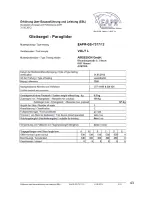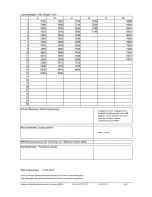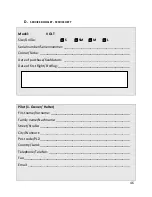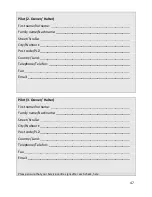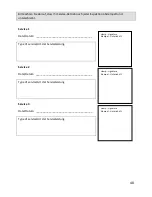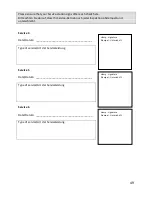
34
For long-term storage do not pack the glider too tightly. Leave the rucksack zip open
when possible to allow any moisture to evaporate.
Transport:
Some materials used in the construction of the glider are sensitive to temperature. Therefore,
the pilot should ensure that the glider is not exposed to excessive heat. For instance, do not
leave the glider in a car during hot summer days.
When packing to send by post use appropriate packing material.
Cleaning:
For cleaning just use only a soft sponge and clean water.
Do not use solvents, cleaners or abrasives.
Repairs:
Repairs must be done exclusively by the manufacturer, importer or authorised persons.
Use only original parts.
In case of questions please contact AIRDESIGN directly.
Material wear:
The VOLT consists mainly of Nylon cloth.
This material does not lose much strength or become porosity through exposure to UV
radiation. However, despite this, the pilot should take care to not expose the glider
unnecessarily to sunlight. Unpack shortly before take-off and pack the glider right after landing.
The VOLT is lined with unsheathed Aramid lines in the top- and middle cascades and with
sheathed Aramid-lines at the main-lines. Take care not to stress any line mechanically.
Overloading should be avoided as a stretching is non-reversible. Continuous bending of Aramid
lines at the same spot weakens the strength.
When putting the glider to the ground avoid dirt and dust as much as possible. Dirt can get
between the fibres of the lines which may shorten the lines and damage the covering.
When lines get caught during take-off, they can stretch or even break. Do not step on lines.
Sharp edges on the ground can damage the sheathing.
A brake line tangled around other lines can tear or cause damage.
Take care that no snow, stones or sand get into the canopy. The weight can pull down the
trailing edge and slows the glider. In the worst case scenario, the glider can be caused to stall.
When launching in strong winds the canopy can, if not controlled, overshoot and hit the
ground hard. This can lead to tears in the ribs or damage the sail or stitching.
When landing, avoid the leading edge hitting the ground in front of the pilot. This can damage
the materials in the leading edge.
After landings in trees or water the line length must be checked. After contact with salt water
wash the glider immediately with clean water.
Avoid contact between the fabric and sweat.
Do not pull the glider over rough ground; his can damage the cloth at the contact points.
Do not too pack the glider too tightly.
The total line length documents for each size of the VOLT are found in the annex.
Summary of Contents for Volt
Page 20: ...36 A ANHANG ANNEX a Übersichtszeichnung Overview ...
Page 21: ...37 b Leinenplan line plan ...
Page 22: ...38 ...
Page 25: ...41 C EBL DDP ...
Page 26: ...42 ...
Page 27: ...43 ...
Page 28: ...44 ...
Page 29: ...45 ...
Page 34: ......
























